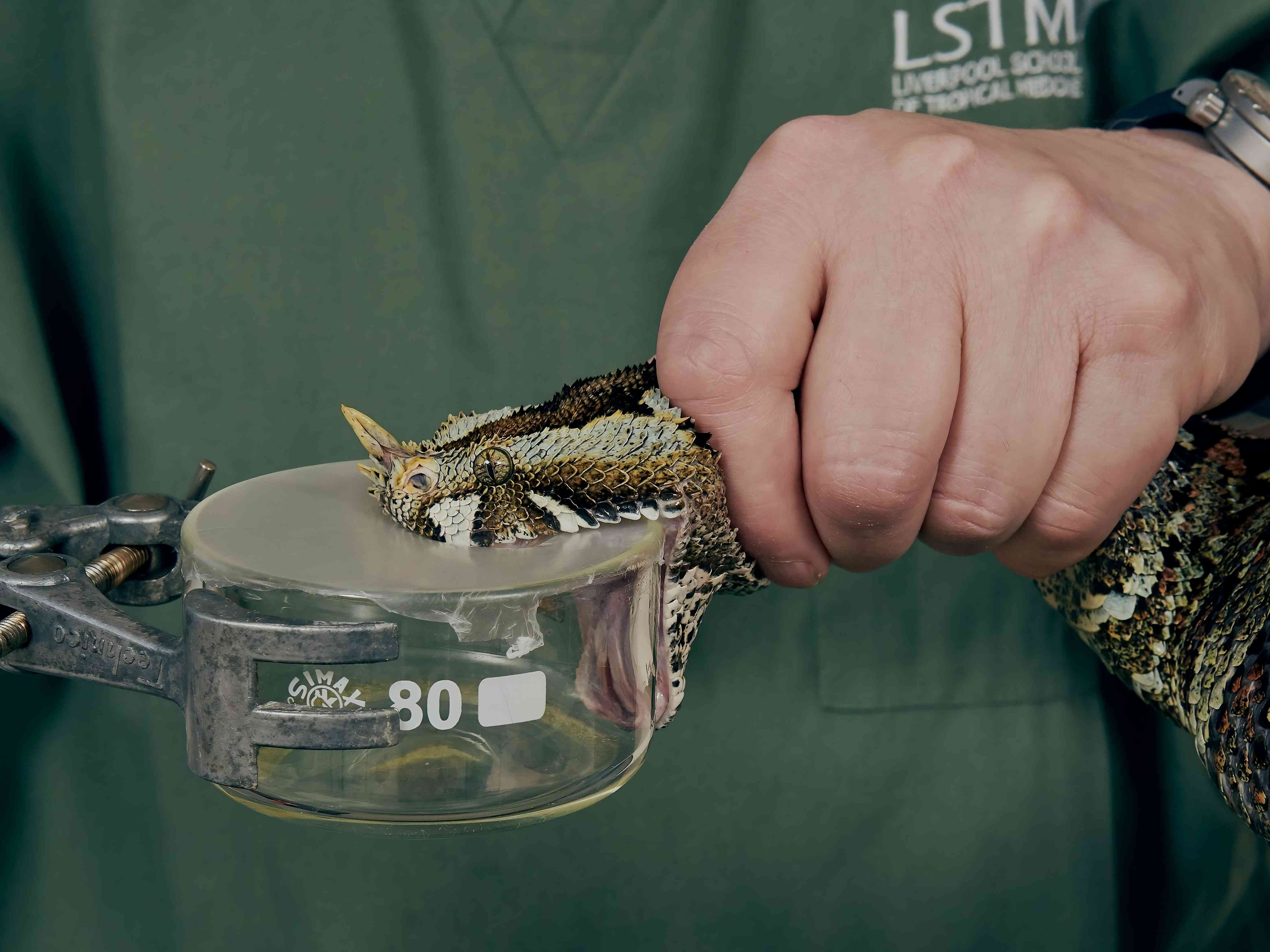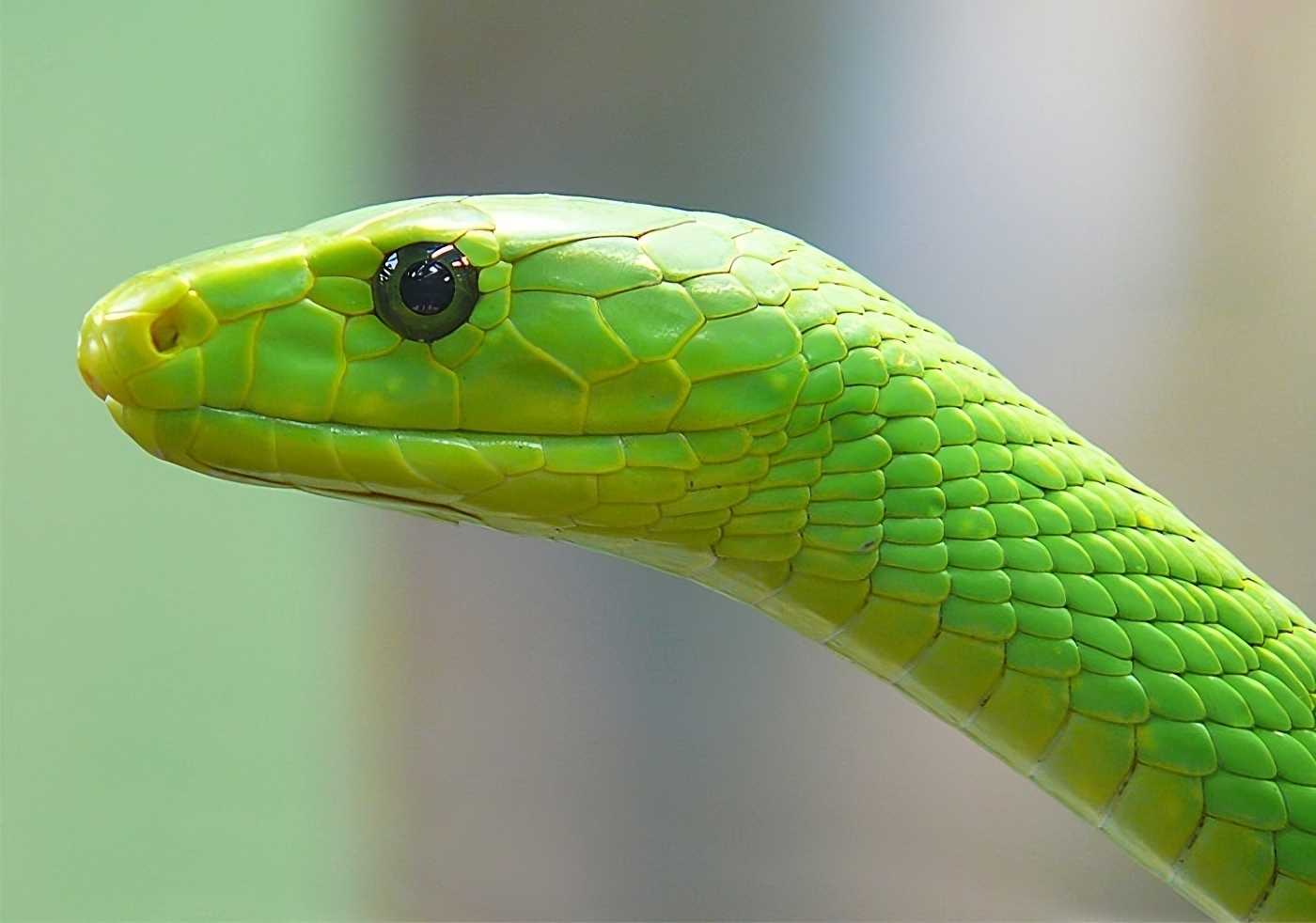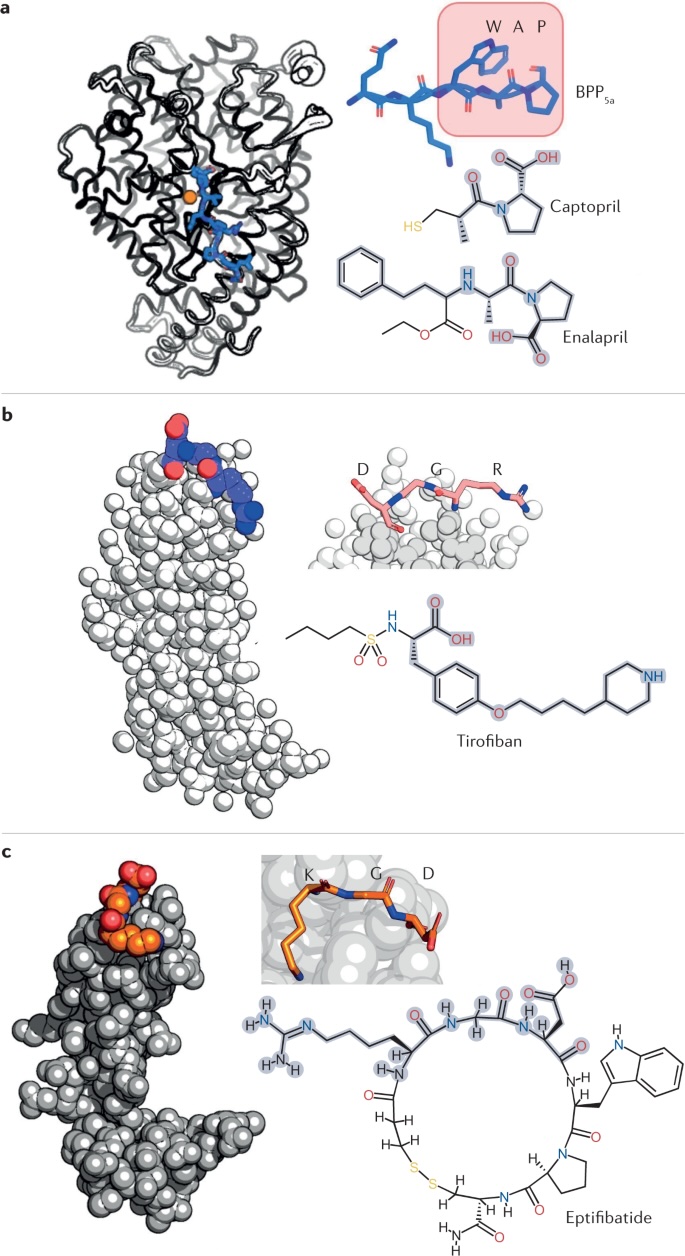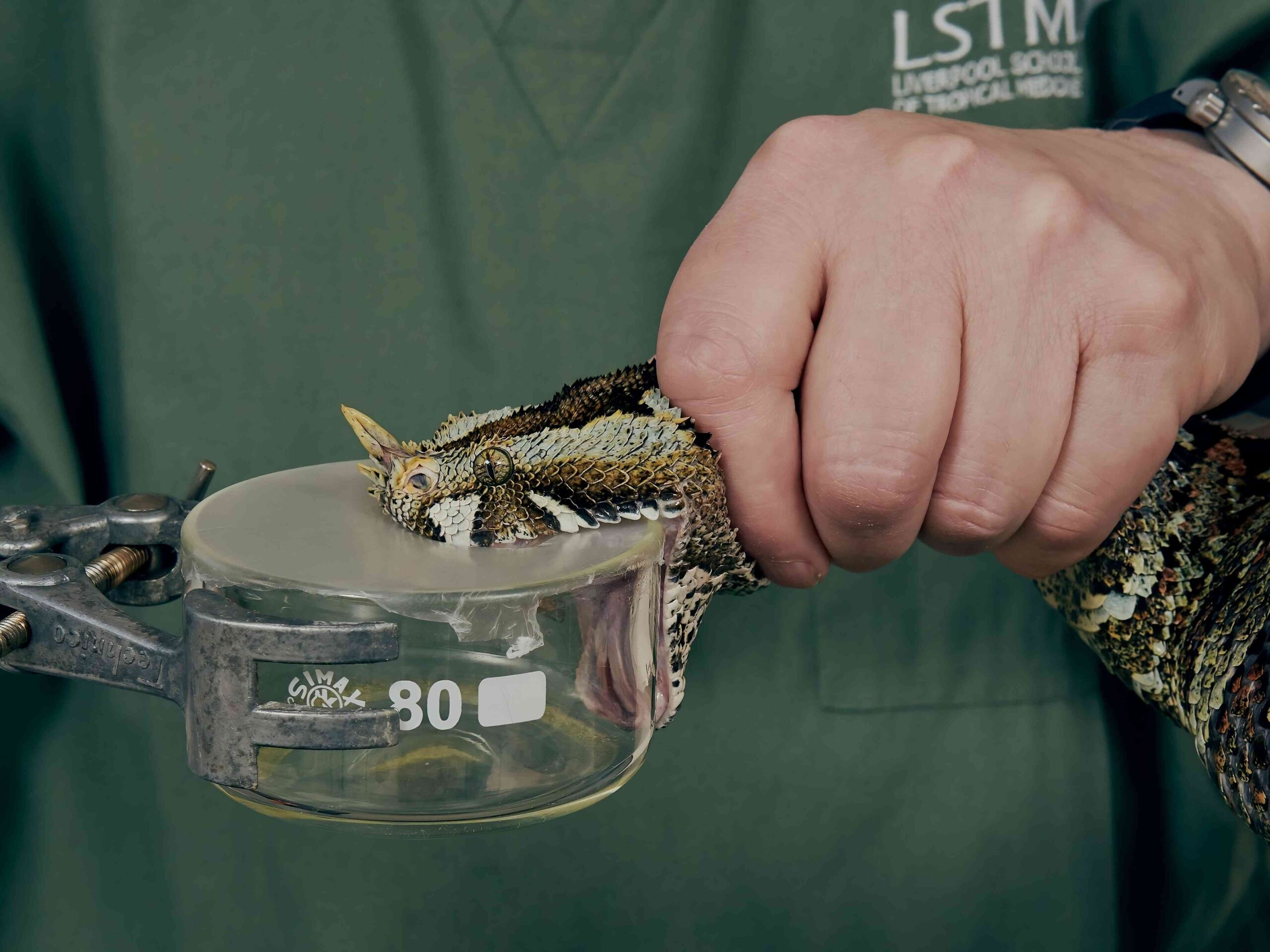Snake venom is a potent and usually yellow fluid that is stored within the specialized salivary glands of venomous snakes. These glands produce venom as a means for these snakes to incapacitate and immobilize their prey. It’s important to note that there are numerous species of venomous snakes, each with their own unique venom composition and effects.
Venom is composed of a complex mixture of proteins, enzymes, and other molecular substances. These components work together to exert various toxic effects on the target organism. The specific composition of snake venom can vary significantly among different snake species, leading to a wide range of symptoms and outcomes upon envenomation.
These harmful substances function by causing cell destruction, impairing nerve impulses, or both. Snakes employ their venom strategically, injecting an appropriate amount to incapacitate their prey or protect themselves from predators. The venom of snakes has the ability to break down cells and tissues, potentially resulting in paralysis, internal bleeding, and fatality for the individual bitten. In order to have an effect, the venom needs to be introduced into the tissues or bloodstream. Despite its extreme potency and lethality, scientists utilize compounds found in snake venom to create medications for the treatment of human ailments.
Structure of Snake Venom
Snake venom is a specialized liquid secretion originating from the venomous snakes’ salivary glands. Its primary purpose is to immobilize prey and aid in the digestion process.
The fundamental building block of snake venom is protein, which encompasses the majority of the venom’s detrimental effects. These toxic proteins are responsible for the harmful consequences associated with snake venom. Additionally, snake venom contains enzymes that accelerate chemical reactions by breaking chemical bonds within large molecules. These enzymes facilitate the breakdown of carbohydrates, proteins, phospholipids, and nucleotides in the prey. Furthermore, toxic enzymes within the venom contribute to the reduction of blood pressure, destruction of red blood cells, and impairment of muscle control.
Another vital component found in snake venom is the polypeptide toxin. Polypeptides are chains of amino acids, typically comprising 50 or fewer amino acids. Polypeptide toxins disrupt cellular function, ultimately resulting in cell death. While certain toxic constituents of snake venom are present in all venomous snake species, others are unique to specific snake species.
Three Main Types of Snake Venom: Cytotoxins, Neurotoxins and Hemotoxins
Snake venoms consist of a complex combination of toxins, enzymes, and non-toxic substances, and they are scientifically categorized into three primary types: cytotoxins, neurotoxins, and hemotoxins. There are also additional snake toxin types that specifically affect certain cell types, such as cardiotoxins, myotoxins, and nephrotoxins.
Cytotoxins are toxic substances that cause the destruction of body cells. They can lead to the death of a large portion or all of the cells within a tissue or organ, a condition known as necrosis. In some cases, tissues may undergo liquefying necrosis, where the tissue partially or completely liquefies. Cytotoxins aid in the partial digestion of prey before it is consumed. These toxins typically target specific cell types. For instance, cardiotoxins specifically damage heart cells, myotoxins dissolve muscle cells, and nephrotoxins destroy kidney cells. Many venomous snake species possess a combination of cytotoxins, and some can also produce neurotoxins or hemotoxins. Cytotoxins achieve their destructive effects by damaging the cell membrane, inducing cell lysis, or triggering programmed cell death, known as apoptosis. At the site of the snakebite, cytotoxins typically cause the majority of visible tissue damage.
Neurotoxins are chemical substances that are toxic to the nervous system. They disrupt the chemical signals, known as neurotransmitters, that are transmitted between neurons. Neurotoxins can diminish neurotransmitter production or block neurotransmitter uptake sites. Snake neurotoxins operate by blocking voltage-gated calcium channels and voltage-gated potassium channels, which are crucial for transmitting signals along neurons. The effects of neurotoxins include muscle paralysis, which can lead to breathing difficulties and potentially death. Snakes belonging to the Elapidae family, which have small, erect fangs, are known to produce neurotoxic venom. This family includes cobras, mambas, sea snakes, death vipers, and coral snakes.
Examples of Snake Neurotoxins
- Calciseptine is a neurotoxin that interferes with the transmission of nerve impulses by blocking voltage-gated calcium channels. This particular venom is utilized by the Black Mamba.
- Cobrotoxin, produced by cobras, induces paralysis by blocking nicotinic acetylcholine receptors.
- Calcicludine, similar to calciseptine, acts by blocking voltage-gated calcium channels, disrupting nerve signal transmission. It is present in the venom of the Eastern Green Mamba.
- Fasciculin-I, also found in the Eastern Green Mamba, inhibits the function of acetylcholinesterase, leading to uncontrolled muscle movements, convulsions, and respiratory paralysis.
- Calliotoxin, produced by the Blue Coral Snake (Calliophis bivirgatus), targets sodium channels and prevents their closure, resulting in paralysis of the entire body.
Hemotoxins are substances that act as blood poisons, exhibiting cytotoxic effects and disrupting normal blood clotting processes. These toxins operate by causing damage to cells, including red blood cells, and interfering with the functioning of blood clotting factors. Hemotoxins can induce tissue necrosis and organ damage. The destruction of red blood cells and the interference with blood clotting can lead to severe internal bleeding. Although the accumulation of damaged red blood cells can potentially have an impact on kidney function, it is not a direct effect of hemotoxins. Certain hemotoxins inhibit blood clotting, while others can cause platelets and other blood cells to aggregate, forming clots that obstruct blood circulation within vessels and can result in heart failure. Hemotoxins are produced by snakes of the Viperidae family, which includes vipers and pit vipers.
Distribution and Injection System of Snake Venom

The majority of venomous snakes administer venom to their prey by injecting it through their specialized fangs. These fangs are highly efficient in delivering venom as they puncture the tissue, enabling the venom to flow into the wound. Additionally, certain snakes have the ability to spit or excrete venom as a defensive tactic.
The venom injection system of snakes comprises four key components: venom glands, muscles, ducts, and fangs. The venom glands are responsible for producing and storing the venom. The muscles surrounding the venom glands exert pressure, aiding in the expulsion of venom when the snake bites. Ducts act as conduits, transferring the venom from the glands to the fangs. Finally, the fangs themselves are the specialized teeth that possess a hollow or grooved structure, allowing venom to flow through them and into the target’s tissues.
Viperidae
Snakes belonging to the Viperidae family possess a highly sophisticated injection system. They continuously produce and store venom within their venom glands. Prior to striking, vipers raise their front fangs in anticipation of biting. Following the bite, the muscles surrounding the venom glands initiate the flow of venom through the ducts and into the closed fang canals. The amount of venom injected is controlled by the snake and varies based on the size of the prey. Typically, vipers release their prey after delivering the venom. The snake then waits for the venom to take effect, causing the prey to become immobilized. This strategic approach enables vipers to efficiently subdue their prey and consume it once it becomes incapacitated.
Elapidae
Snakes belonging to the family Elapidae, such as cobras, mambas, and coral snakes, possess a venom production and injection system that differs from that of vipers. Unlike vipers, most elapids do not have movable front fangs. However, there is an exception within the elapid family known as the Death Viper. Instead, elapids typically have short, small fangs that are fixed and erect.
After delivering a bite, elapids often grasp and chew their prey, aiding in the optimal release of venom. This chewing action helps ensure that a sufficient amount of venom is injected into the prey. Although the specific mechanisms may vary among different elapid species, this characteristic behavior of grasping and chewing assists in the efficient delivery of venom and maximizes the prey’s exposure to its toxic effects.
Colubridae
Venomous snakes belonging to the family Colubridae possess a unique venom delivery system. They have a single open canal on each fang, which serves as a pathway for venom. Unlike other venomous snake families, colubrids generally have fixed rear fangs.
During hunting, venomous colubrids engage in a chewing motion while injecting venom into their prey. This behavior facilitates the efficient delivery of venom. It is important to note that colubrid venom typically has less severe effects on humans compared to the venom of elapids or vipers. However, it is crucial to exercise caution and respect when encountering any venomous snake.
While most colubrids pose minimal threat to humans, there are exceptions. For example, the venom of the boomslang and Thelotornis snakes, both members of the Colubridae family, has been known to cause human fatalities. Therefore, it is essential to exercise caution and seek immediate medical attention if bitten by any venomous snake, regardless of the family to which it belongs.
Are Snakes Immune to Their Own Venom?

Venomous snakes are not harmed by the venom they use to kill their prey due to several factors. One key reason is that the primary component of snake venom is protein-based toxins. These toxins need to be injected into body tissues or the bloodstream to be effective. When a venomous snake consumes its poisoned prey, the venom encounters stomach acids and digestive enzymes, which break down the protein toxins into their basic components, such as amino acids. This process neutralizes the toxic effects of the protein-based toxins.
Moreover, venomous snakes have developed safeguards to become immune or less sensitive to their own venom. The structure and positioning of their venom glands prevent the venom from flowing back into their own body. If a venomous snake is bitten by another snake of the same species, it can produce antibodies or venoms that provide protection against their own toxins.
Researchers have also discovered specialized adaptations in certain venomous snakes. For example, some cobras possess modified acetylcholine receptors in their muscles, which prevent their own neurotoxins from binding to these receptors. This prevents paralysis and death caused by the snake’s own neurotoxins. The presence of customized acetylcholine receptors is a key factor in cobras’ immunity to their own venom.
While venomous snakes are not vulnerable to their own venom, they are still susceptible to the venom of other venomous snake species. Each species of venomous snake produces a unique combination of toxins that may affect other species differently, and cross-species venom interactions can be dangerous or lethal.
Medical Uses of Snake Venom

In addition to the production of antivenoms, the study of snake venoms and their biological effects has gained increasing importance in the discovery of new strategies for combating human diseases. Conditions such as stroke, Alzheimer’s disease, cancer, and heart disease are among the targeted diseases. Snake toxins, with their specific targeting of cells, have become a focus of research to understand their mechanisms of action and develop drugs that can selectively target specific cells. Through the analysis of snake venom components, researchers have made advancements in developing more potent painkillers and more effective blood thinners.
The anticoagulant properties of hemotoxins have been harnessed by researchers to develop drugs used in the treatment of high blood pressure, blood disorders, and heart attacks. Neurotoxins derived from snake venoms have been utilized to develop drugs for the treatment of brain diseases and strokes.
The first venom-based drug approved by the FDA was captopril, derived from Brazilian vipers, which is used in the treatment of high blood pressure. Other drugs derived from venom include eptifibatide (from rattlesnakes) and tirofiban (from African saw-scaled viper snakes), which are used for the treatment of heart attacks and chest pain.
